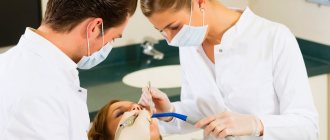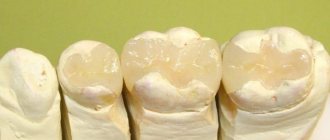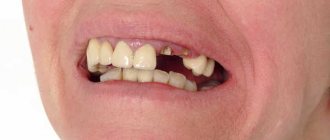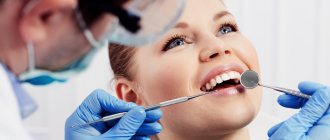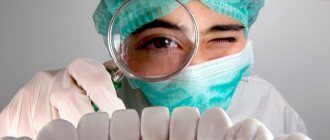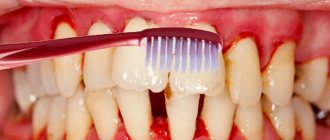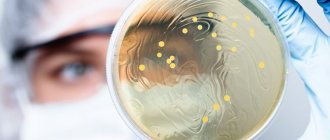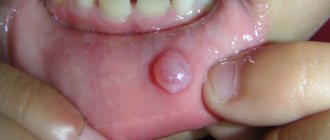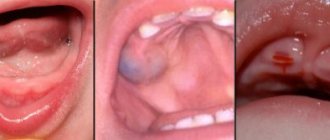Dysbacteriosis of the oral cavity is characterized by a change in the normal composition of the microflora in this area. During a dysbiotic failure, harmful organisms begin to attack not only the mucous membranes, but also the bone component.
As a result, the dentition loses its strength, and in the absence of treatment, active tissue destruction begins, affecting all structures of the oral cavity.
Dysbacteriosis is an imbalance between conventional and pathogenic microflora, when harmful bacteria begin to predominate in quantitative or qualitative composition, provoking a number of complications.
The growth of pathogenic microflora can be influenced by both external and internal factors. In dysbiosis, active reproduction of microorganisms of opportunistic flora leads to a decrease in the functionality and quantitative composition of bifidobacteria. In this case, representatives of pathogenic flora can produce without changes.
Composition of microflora in the mouth
The most common inhabitants of the oral cavity are bacteria. There are more than 500 strains. In addition, the mucous membranes are inhabited by protozoa, fungi and viruses. The number and composition of microflora organisms is individual for each person. All inhabitants of the oral cavity can be divided into 2 groups:
- Obligate or permanent environment . These bacteria are constantly present in the human mouth. The most common are lactobacilli, streptococci, staphylococci, prevotella, and bacteroides.
- Facultative or non-permanent microflora . Its penetration occurs when eating food, migration of organisms from the nasopharynx, intestines, and skin. Typical representatives of this group are pseudomonads, Escherichia coli, and Klebsiella.
Causes of imbalance
A number of factors, both external and internal, can lead to the development of oral dysbiosis:
- Gastrointestinal diseases . When the digestive organs malfunction, metabolic processes in the body slow down and the absorption of nutrients is impaired. When the internal reserve is depleted, an imbalance of the intestinal bacterial environment occurs, which contributes to the occurrence of dysbiosis in other departments.
- Mouthwashes for cleaning the mouth . Most often, these products include antiseptics and alcohol. These components contribute to overdrying of the mucous membranes, which disrupts their structure.
- Having bad habits . Smoking and drinking alcoholic beverages affect the functioning of the salivary glands. As a result of prolonged drying out or excessive moisture in the oral cavity, the composition of the microflora changes.
- Decreased immunity . When the body's resistance decreases, it becomes vulnerable to pathogenic microflora.
- Presence of chronic diseases . If you do not treat existing ailments, the focus of the inflammatory process will gradually affect neighboring organs. Especially if it is located in the oral cavity, for example, caries, stomatitis.
- Poor nutrition . A lack of vitamins in the diet leads to vitamin deficiency.
- Taking certain medications . Antibiotics and antiseptics mainly have a negative effect on the composition of microflora.
Plaque removers
Plaque in the oral cavity is removed, first of all, mechanically. Plaque removal is usually done using:
- Toothbrush: The mechanical action of a toothbrush, together with the antibacterial action of toothpaste, helps remove plaque from the surface of the teeth and tongue.
- Dental floss is used to remove plaque from interdental spaces. You can also use mouthwashes to enhance the antibacterial effect.
- Dental brush: This is an alternative tool to dental floss as it is also used to remove plaque from between teeth. Should not be used in case of crooked teeth.
If the plaque is too persistent...For better plaque removal, you can use tablets that color plaque red. If plaque cannot be removed on your own, you should contact your dentist to clean your teeth using special dental instruments. |
You can also use natural remedies to remove bacterial plaque. Let's see which ones.
Natural Plaque Removers
To avoid or reduce the accumulation of plaque at the oral cavity level, you can use toothpastes or mouthwashes that contain natural substances or substances that help prevent the growth of bacteria.
Among these substances we have:
- Immunoboosting Herbs: Helps strengthen the immune system, which more effectively fights bacteria present at the oral level. Among them, we highlight the berries of hawthorn, rose hips and echinacea.
- Fluoride: This trace element strengthens tooth enamel and at the same time inhibits the growth of bacteria. Often included in toothpastes and mouthwashes.
- Chitosan: Used in toothpastes as it has a strong antibacterial effect and hence helps prevent the growth of bacteria.
Features of the clinical picture
The appearance of certain symptoms depends on the degree of development of dysbiosis in the mouth. There are 4 stages of the disease:
- Latent phase . A dysbiotic shift is characterized by a slight change in the amount of one strain of pathogenic microorganisms. There are no symptoms.
- The subcompensated stage is characterized by a decrease in lactobacilli. The signs of the disease are blurry.
- Pathogenicity of monocultures . Lactobacilli are diagnosed in minimal quantities; the oral cavity is inhabited by a facultative pathogenic environment. Signs of dysbiosis are clearly visible.
- Decompensated form of the disease . At this stage, in addition to severe symptoms, the growth of yeast-like fungi occurs. The very first sign of the disease is the appearance of bad breath. Then an uncharacteristic taste and burning sensation occurs. These symptoms are supplemented by dysfunction of the salivary glands.
In an advanced state with dysbacteriosis of the oral mucosa, the following symptoms are observed:
- inflammation of the mucous membranes and gums;
- the presence of plaque on the surface of the tongue and teeth;
- bleeding gums;
- the appearance of ulcers and blisters, with a simultaneous increase in body temperature;
- swelling, hyperemia and soreness of the tongue;
- dryness of the skin of the face, in particular the area around the lips. Characteristic is the appearance of sticking in the corners of the mouth and peeling of nearby surfaces.
Who lives in the oral cavity
The mucous membrane is populated mainly by bacteria. Much less fungi, viruses and protozoa are detected. Let us recall the designation of biological terms:
- Bacteria are cellular formations capable of full life activity.
- Viruses are protein elements capable of reproducing and parasitizing inside cells.
Oral mucosa - Mushrooms are classified into a separate kingdom and are classified according to the presence of characteristics inherent in plants and animals. They are distinguished by their inability to synthesize organic substances. Unhindered proliferation of fungi leads to damage to the attacked living mucosal tissues.
- Protozoa are elementary organisms, including hundreds of subspecies. This includes the causative agent of amebiasis, which manifests itself in intestinal dysbiosis.
The listed organisms live peacefully inside the oral cavity until a key event occurs.
Diagnostic criteria
Making a diagnosis of dysbacteriosis is often difficult, this is explained by the absence of obvious manifestations at the initial stage of the disease and individual differences in the composition of the microflora of the oral cavity of each person. However, if the presence of dysbiosis is suspected, the dentist sends a smear from the surface of the mucous membranes or an analysis of the patient’s saliva for microbiological examination.
The material is collected on an empty stomach. There should be no food particles on the surface of the enamel, otherwise the test result will be unreliable.
In addition, the patient needs to donate blood and urine. Additional examinations are prescribed according to test indications. Sometimes several specialists are involved in the further course of the disease. This could be a therapist, gastroenterologist, immunologist, nutritionist, infectious disease specialist.
Therapy methods
Depending on the examination indicators and the nature of the pathogen, treatment of oral dysbiosis may include:
- Sanitation of the oral cavity. In this case, it is necessary to remove tartar, fill all diseased teeth, and treat the gums and mucous membranes.
- Taking antiseptics to eliminate pathogenic microorganisms.
- Use of immunostimulants. Such drugs help strengthen the body's defenses.
- Prescription of probiotics. They restore the balance of beneficial bacteria.
- Taking vitamin complexes is indicated for vitamin deficiency and for general strengthening of the body. The correct selection of appropriate components promotes cell regeneration and strengthening of bone tissue.
- Antifungal agents (for candidiasis) and antibiotics (indicated only for severe dysbiosis) are prescribed extremely rarely.
In addition to taking appropriate medications to improve the effectiveness of therapy during the treatment period, it is recommended to follow the following rules:
- give up bad habits: smoking and drinking alcohol;
- refrain from oral sex;
- review nutrition, paying special attention to products of plant origin;
- After each meal, you need to clean your mouth of food debris.
The duration of treatment depends on the stage of the disease, the presence of foci of inflammation and existing complications. On average, this period is 2-4 weeks.
Prevention of dysbacteriosis
In order to prevent the development of oral dysbiosis, it is necessary to take preventive measures. Hygienic care of teeth and gums should be carried out in full twice a day. After brushing, the mouth should be rinsed with special prophylactic agents, and the teeth should be treated with dental floss immediately after eating.
Timely visits to the dentist are also required, at which pathological changes can be detected in the early stages. Early diagnosis guarantees successful treatment without the use of expensive drugs.
After completing a course of antibiotics and other drugs that are potentially dangerous from the point of view of the development of dysbiosis, it is necessary to monitor changes in health status. Usually, along with such medications, products containing beneficial bacteria are prescribed, the use of which prevents their reduction.
To prevent dysbiosis, probiotics should be taken in parallel with antibiotics.
Additional Information! For chronic diseases of the stomach and intestines, it is recommended to adhere to a special diet. Compliance with it will help balance the bacterial composition of the entire tract, including the oral cavity.
Possible consequences
In the absence of timely adequate therapy, the patient begins the process of destruction of bone tissue, caries, pulpitis, and cysts appear. Further pathological changes affect the oral mucosa in the form of stomatitis and gingivitis.
The gums, losing their protective functions, begin to bleed and become inflamed, which is due to the influence of periodontitis and periodontal disease. When a fungal carrier penetrates, candidiasis occurs.
All these pathological changes lead to early loss of dentition. In addition to inflammatory processes in the oral cavity, the infection can spread to other parts of the body: the nasopharynx and gastrointestinal tract, causing various diseases of the internal organs.
Preventive measures
To avoid oral dysbiosis and its complications, it is not enough to simply clean the oral cavity twice a day. The issue must be approached comprehensively:
- you need to properly plan your diet, avoiding prohibited foods that destroy the protective membrane of the mucous membranes;
- It is worth treating diseases of internal organs in a timely manner; any inflammatory process in the body affects the human immune system, which leads to a decrease in resistance to pathogenic microflora;
- it is necessary to periodically take vitamin complexes;
- It is recommended to stop drinking alcohol and smoking.
The appearance of dysbacteriosis in the oral cavity negatively affects the condition of the mucous membranes and bone tissue of the dentition. Without proper treatment, you can quickly lose your beautiful and snow-white smile.
Why does dysbacteriosis cause bad breath?
Clinical studies in the field of microbiology have shown that oral dysbiosis and unpleasant odor always accompany each other. The culprits are opportunistic microorganisms. Anaerobic bacteria are found here. They love protein foods (meat, dairy products).
Bacteria feed on food debris between teeth and dead epithelial cells. Microorganisms live mainly on the tongue. Their presence can be easily verified by looking into your mouth in the morning. A white coating is found on the tongue. To remove unpleasant odor and reduce the number of bacteria, you should thoroughly brush your teeth twice a day. The back of the toothbrush has a grooved surface for cleaning the tongue. This helps get rid of white plaque and unpleasant odor.
